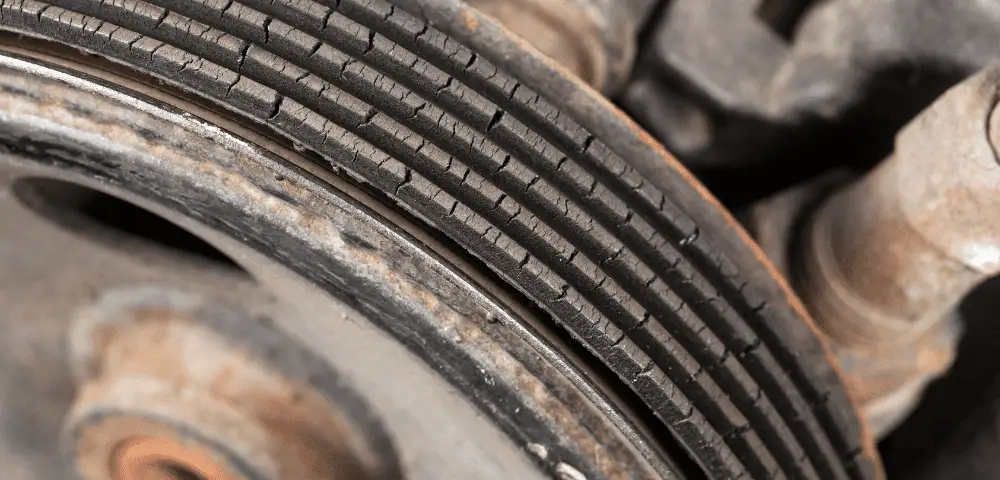Owning a car comes with a lot of unchartered territory from common issues like a flat tire or a dead battery to complicated engine problems.
There are a lot of issues where you must have a basic idea of what needs to be done before the car reaches a workshop for repairs.
One uncommon, but very possible issue is the failure of a serpentine belt while you are on the road.
This text will explore the aftereffects of serpentine belt failure and discuss ways to prevent it from happening.
What is a Serpentine Belt?
Before discussing the serpentine belt breaking, let’s take a moment to understand what it actually is and how it operates.
A serpentine belt sometimes referred to as the drive belt or an accessory belt is long.
A rubber belt that operates various components of the engine, such as the alternator, power steering pump, and air conditioning compressor.
In essence, serpentine belts of modern cars are responsible for operating all the essential electrical components to keep the car running and maintain the comfort level of the occupants by running the air conditioning as well.
The name serpentine comes from the fact that the long belt snakes through several systems of the engine to create a path for itself, just like a large snake or a serpent.
The Importance of Serpentine Belts
You might wonder that ok, the serpentine belt runs the AC and some electrical components. So it may not be as important as an integral engine component or an assembly like the timing belt.
However, the reality is quite different.
Today, modern cars require input from a lot of electrical components.
From fuel injection, to steering control, and the engine cooling system. Every system depends on the alternator which will only run if the serpentine belt is intact.
The serpentine belt is among critical engine components, especially for modern cars, and your vehicle would ultimately come to a halt if it fails.
What Happens When the Serpentine Belt Fails?
So, it’s established that the serpentine belt is crucial for the smooth operation of any car. Let’s discuss what happens when it fails or breaks.
If it happens while driving, you might have a significant problem with your hands.
Your car won’t immediately stop as the engine will continue to get fuel input. However, it will continue to deteriorate as the cooling system won’t be working, resulting in a huge problem down the line.
When the serpentine belt breaks, the components that it powers will stop working.
Depending on the vehicle, this can include the alternator, power steering pump, air conditioning compressor, and water pump.
All of these are essential components and some of them can contribute immediately to damaging your engine.
So, let’s see what the major issues will be:
Engine Damage
One of the most significant consequences of a serpentine belt failure is engine damage.
Without the serpentine belt to power the water pump, the engine may overheat, which can cause damage to the engine’s internal components.
Overheating can also cause the engine to seize, which can be catastrophic for both your car and wallet.
Unexpected Breakdowns
Even if you have a separate fan belt in the car, a damaged serpentine belt can still stop your car on the road.
It’s responsible for running the alternator and if the alternator stops working, the battery will no longer charge, resulting in the failure of your vehicle’s electrical systems.
As a result, your car can break down and may leave you stranded on the road.
Power Steering Failure
A serpentine belt failure can also cause a loss of power steering.
Without the power steering pump working, it will be difficult to steer the vehicle, especially at low speeds. This can be dangerous and make it challenging to navigate through traffic.
Battery Damage
The final issue is battery failure. In the case of a failing alternator, the battery will continue to power the vehicle’s electrical systems until it is drained completely. This can result in a dead battery, which is quite costly.
How to Prevent Serpentine Belt Failure?
Preventive maintenance is crucial to prevent a serpentine belt failure. You should have your serpentine belt inspected regularly, usually during routine maintenance such as an oil change or tire rotation.
Check for any signs of wear and tear, such as cracks or fraying, and replace the belt when necessary.
It’s also essential to replace the serpentine belt according to the manufacturer’s recommended schedule.
Typically, serpentine belts should be replaced every 60,000 to 100,000 miles, depending on the vehicle and driving conditions.
In addition to regular inspections and replacement, you can also prevent a serpentine belt failure by keeping the engine clean and free of debris. Dirt and debris can build up around the belt, causing it to slip or wear down more quickly.
Key Takeaways
Some people have a misconception that the serpentine belt is not too important because it’s so easy to replace and doesn’t stall the car immediately.
However, it drives key components in your car including the coolant pump and the alternator.
Effective preventive maintenance is the best way to ensure that it always remains operational and doesn’t fail during use, which can potentially lead to significant damage in the long run.


